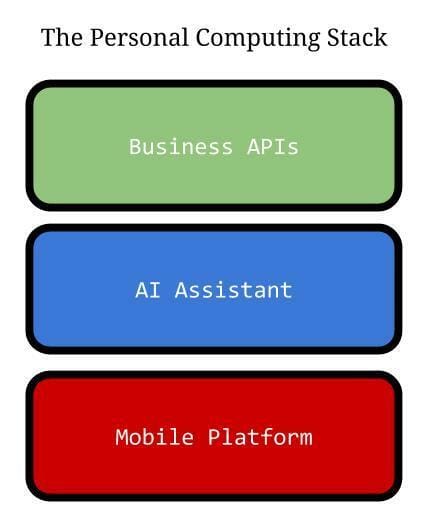From Apps to AI

There was a time when Foursquare was the coolest thing ever.
You could check into places you went, people would see that, and you could become the "mayor" of those places. But it required that you used the app, and that others were using it too.
Question: What killed it?Answer: Facebook.
But why? How was Facebook, who was busy doing other things, able to come up with similar features that knocked out Foursquare so quickly?
The answer is that Facebook was (and still is) one of our central computing interfaces. Google is another one—along with Snapchat and Instagram for some.
What’s important is that people don’t want to switch apps, so if the core functionality applications (Google,Facebook,etc.) can add another company’s features to its platform, people will often drop the standalone app.
What’s fun is thinking about how this continues through time—not just for apps, but for layers deeper in the stack.
My prediction (and conceptualization) is that interaction tends to move downward or inward, i.e. in the direction of native, natural, and low-friction interaction.
Facebook is lower in—or more center to—peoples’ natural workflows than Foursquare because people basically use it like AOL’s portal. So, over time, Foursquare drops off and Facebook keeps being used (assuming it has enough of the functionality of the app being dropped).
More fundamental integration
So the question is: **What can do to Facebook what Facebook does to apps like Foursquare?
The answer is Digital Assistants.
Once Digital Assistants cross the threshold of being natural instead of novel, they will be the interface that people use to do so many things, from ordering products, to buying tickets, to deciding what to watch, what to eat, etc.
And here’s the key: that all sits on a mobile platform.
Digital Assistants are going to be integrated into your mobile OS. They’ll follow you to work and on your laptop and desktop as well, but mobile is the center of the universe because it’s always with you.
So, your Digital Assistant (DA) will be your way of getting most things done, and it will be tied, most importantly to your mobile ecosystem—which, ideally, is also your main tech ecosystem.
Now, where does that leave applications?
Get a weekly breakdown of what's happening in security and tech—and why it matters.
Who’s going to pick up their phone and open the Uber app when you can just say:
Get me an Uber home.
Who’s going to open the Amazon app (or website) when you can just say:
Find me the best shaving cream on Amazon.
The natural, intuitive, least-friction, and most efficient way to do almost everything will be to use your voice, and to have the AI capabilities of your DA sort it out.
Applications—in the sense of things you manually open and poke around on—become legacy. And what you end up with is companies publishing that same functionality as APIs made to be consumed by Digital Assistants.
Basically, your stack will be:
Your Mobile OS as the Platform (low level)
Your Digital Assistant as your interface
Every company’s APIs as the resources that the Digital Assistants use to make things happen for you
This is the transition I think we’re in, and once Digital Assistants hit their maturity sweet spot we’re going to move very quickly towards this model.
Let’s talk about how to get ready.